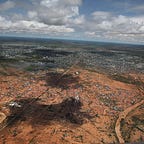It takes a village to bring about change in Somalia
How community involvement is the driving force behind UNICEF and WFP’s resilience programme
Makeshift dome tents dot the Kabasa Displaced People’s Camp in Dolow, southern Somalia. Set up in 2011 to host those displaced by insecurity and persistent droughts, it is now home to 50,000 people, whose survival depends exclusively on humanitarian assistance. Half of the camp’s residents are women and children.
Here, Germany’s generous support enables UNICEF and WFP, together with the Ministry of Health, to run a resilience programme that ensures vulnerable mothers and children receive the nutrition, health, sanitation and hygiene services they need. Two community-based groups, the Community Development Committees (CDC) and the Community Workers (CW), are the driving force behind implementation of this programme.
CDC members — which comprise elected or nominated village residents, leaders and elders — play a variety of roles that ensure families in Kabasa are served well.
“CDC members were trained on various community dynamics and processes, from community planning and mapping to management of resources and conflict resolution from the outset of the programme,” says UNICEF Nutrition Officer Fatmata Fatima Sesay.
“Before we endorse any activity by any external organization, we meet with families and listen to their needs. For example, we need to know why certain families are not able to access water or the toilets are not kept clean,” a CDC member explains. There are regular meetings with families to find out about issues that might need immediate attention and action.
Working alongside the CDCs are Community Workers (CWs) — volunteers who commit time and efforts to improve the health and nutrition of camp residents. They carry out screenings for acute malnutrition, refer cases to the nutrition centres or hospitals, make house calls to check on mothers and children, and ensure that families put in place the right nutrition, health, hygiene and sanitation practices.
“With my house calls, families got to know me better, I am no longer a stranger to them,” said Salah Mohamed Ali, one of 17 CWs serving mothers and children in Kabasa. “Mothers feel more at ease to talk about problems affecting their kids. And the babies smile and do not cry anymore when they see me,” she adds.
CWs are also involved in teaching women how to prepare healthy and diversified food that is rich in vitamins and minerals, and promote exclusive breastfeeding, a good practice for the first six months of a child’s life. CW Liin Shiaaeiye Ali, regularly conducts cooking lessons in the camp and says mothers are enthusiastic to learn new recipes using vegetables grown by local farmers.
The lack of water supply and sanitation is one of the main causes of malnutrition among families in Kabasa. CWs like Salah and Liin ensure that families understand the importance of safe water, sanitation and hygiene practices in preventing malnutrition.
“The network of CWs and CDCs has been the driving force behind this resilience programme. Without them, it would have been impossible for us to reach all those vulnerable mothers and children with nutrition and health assistance,” says WFP Programme Abdikafi Abdullahi.
The 3-year German-funded resilience programme is now in its second year of implementation. While the focus is the provision of health, nutrition, hygiene and sanitation services, its overall goal is to build resilience among vulnerable families in Kabasa and in other parts of southwest and southern Somalia.
